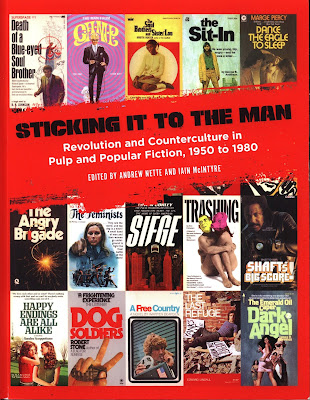edited by Andrew Nette and Iain McIntyre
PM Press, November 2019
In 2012 Iain McIntyre, an Australian writer and musician, edited an anthology of essays on 'pop, protest, and black fiction of the counterculture, 1964 - 1975' titled Sticking it to the Man. Published in the UK by small press publisher The Ledatape Organisation, the book broke new ground in terms of surveying these fields of popular literature, but at only 82 pages in length, necessarily could not provide an in-depth overview.
Building on the success of their 2017 book Girl Gangs, Biker Boys, and Real Cool Cats: Pulp Fiction and Youth Culture, 1950 to 1980, McIntyre and collaborator Andrew Nette, the Australian editor, crime fiction novelist, and author of the Pulp Curry Blog, now have published a greatly expanded version of Sticking, this time with the US publisher PM Press (who specialize in publishing Marxist agitprop ?!).
At 319 pp, this U.S. version of Sticking is a well-made, thick chunk of a trade paperback adhering to the same formatting as Girl Gangs, Biker Boys, and Real Cool Cats. The book features essays from McIntyre and 25 other contributors, all copiously illustrated with photographs / scans of book covers and author portraits.
This photo of one of the Contents pages should provide you with an idea of how the book goes about furnishing an overview of such a variety of popular literature.
One thing to note is that Sticking is much more Scholarly - even pedantic - as compared to the essays provided in Girl Gangs, Biker Boys, and Real Cool Cats. Some of the contributors to Sticking are academics, and their essays would be more at home in journals devoted to literature, sociology, Black History, and other fields in the Humanities. It goes without saying that these essays are overloaded with jargon, and negotiating them requires perseverance.
An example of one of the essays in Sticking, by Andrew Nette himself, is available here.
That said, there are plenty of other essays and interviews in the pages of Sticking that readers will find readable, engaging, and informative. Essays on black-authored paperbacks of the 60s and 70s, (spotlighting authors such as Iceberg Slim, Donald Goines, Chester Himes, and Joseph Perkins Greene), as well as a 1993 interview with Nathan Heard (Howard Street, To Reach A Dream) are among the better entries in the book.
Also well worth reading are essays on Death Wish and other vigilante novels of the 70s (I didn't know that sci-fi author Barry M. Malzberg wrote an entire series of 'Lone Wolfe novels under the pseudonym 'Mike Barry' ?!); pulp fiction about the aftermath of the Viet Nam war; novels featuring 'liberated' women, who brought an Amazonian attitude to their interactions with the male gender; men's adventure novels that riffed on the Quebec Separatist movement in Canada in the 1970s; and even Looking for Mr Goodbar, Judith Rossner's 1975 novel about a schoolteacher looking for love in the alienating cityscape of mid-70s New York.
As with Girl Gangs, Biker Boys, and Real Cool Cats, readers will come away from Sticking with a desire to obtain many of the profiled Old School paperbacks, only to come to the disappointing realization that copies of these books are rare, and sell for very high prices.
In this regard, I can't say that Sticking will bring many new revelations to those dedicated collectors (such as readers of The Paperback Fanatic) of old paperbacks, who already know that any book from Holloway House is a treasure. But, perhaps one day, we will see the paperbacks in Girl Gangs and Sticking reissued in trade editions, much like Grady Hendrix has arranged to have selected 'Paperbacks from Hell' reissued by Valancourt Press.


















.jpg)
















